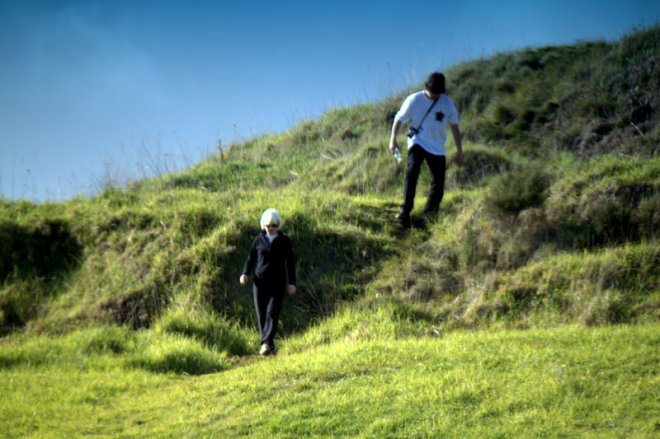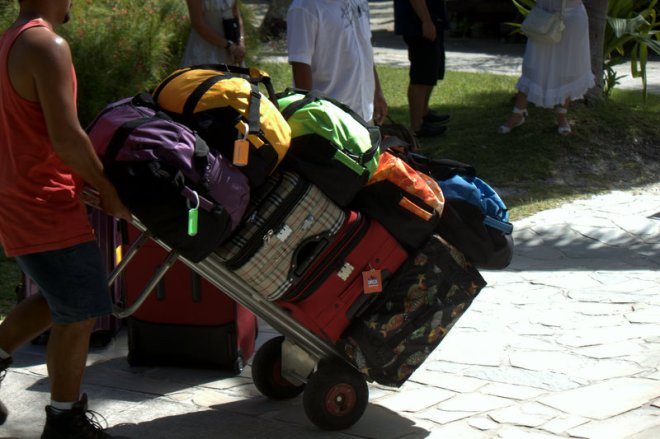Abraham left us in New Zealand and made the 24+ hour journey home, emailing us from LA to say that he had lost his wallet in Auckland after going through passport control but that the immigration officers had helped him find it. This did not surprise me terribly (either that he lost it or that they helped him), as the New Zealand immigration and customs officers are by far the nicest we’ve met.
We were all very sad to see Abraham go and wished he could have traveled on with us, but he had to get back to his summer job. We, meanwhile, got on another plane and headed for the Kingdom of Tonga, our very first view of which looked like this:
The people in the lines definitely did not match up with the signs over the lines (the people in the so-called Special Lane looked exactly like the people in the Tongan Passport Lane, who resembled a lot of people in the Non-Tongan Passport Lane), and somehow we managed to be the last people to go through any of the lanes, though we were by no means the last people to disembark. This, as it turned out, was typical of our experience in Tonga, where we frequently had the feeling that we were missing some crucial piece of information.
In order to fully understand our Tongan experience you need to know that my niece is a kindergarten teacher in California and that her mentor teacher this past year was a Tongan woman named Ana. Now I have never met Ana, though I am hoping to catch up with her in San Francisco on the way home, but I did call her for advice some months ago when I first decided that Tonga should be on our itinerary. She was extremely friendly and helpful and suggested, among other things, that we bring a jar of peanut butter for Dani so that he would have something to eat. What I didn’t realize—what none of us realized—at the time was what it would mean to have a Tongan contact once we actually reached the Kingdom.
We arrived about 8 pm—it was dark, and we were hoping to be met by someone who would take us to the place where we were staying. But when we finally emerged from the airport there were not one but two people waiting for us. The first was the driver from the hotel; the second was Ana’s brother-in-law Sateki, who was making his—wait for it—second trip to the airport that day. Apparently there were two flights in from NZ that day, the first of which had arrived at 2:30 am, and not knowing which of them we would be on, he met them both!
This, however, was just the beginning. After dropping us at our hotel, Sateki drove all the way back home (about 40 minutes) and then returned in a different vehicle which he was giving us to use for as long as we were in Tonga. He and Seven then drove back to his village, Sateki pointing out the landmarks in the dark and Seven memorizing the turns—left at the China Aid sign, left then quick right, left again, past two villages—through a landscape that looks something like this in daylight:
Amazingly Seven succeeded in finding his way back to us by about 1 o’clock in the morning.
By then it was Sunday morning (early) and it turns out that EVERYTHING is shut in the Kingdom of Tonga on Sundays. I do not, by the way, recommend scheduling a Saturday night arrival for anyone considering a visit to Tonga; we, of course, had completely failed to grasp how closed everything would be. There are no stores, no tourist offices, no rental car agencies, no banks, and most importantly almost no restaurants open on Sunday. Had we not had the use of Sateki’s car, we would have been sitting in our bungalow getting hungrier and hungrier—not to mention thirsty since you can’t drink the water in Tonga (you can’t, by the way, drink the water in most of Polynesia)—until Monday morning. Again, this only dawned on us slowly, but over the course of the next couple of days we realized what a lifesaver the loan of this vehicle really was.
Here’s a shot of the place where we did, eventually, find a meal at the westernmost end of the island:
This was a sort of “resort” and at first it looked more or less recognizable, but even here we seemed not to really get what was going on. Here is a picture of us waiting in what we thought was the restaurant—we had by this time ordered food, though admittedly off a rather confusing menu from a girl who didn’t speak much English, while the few other people who came and went only ever seemed to have drinks…
An hour and a half later, we discovered that what we had ordered was lunch, not breakfast, that it wasn’t served until after 1 pm, that it was served in another place entirely, and that it consisted of yummy but completely foreign foods, not one of which we could even tempt Dani into trying. I tried to explain to him that the round purple starchy slices were just a kind of sweetish potato and that chicken was chicken no matter what it looked like, but he wasn’t having any of it. Seven, however, was ecstatic over the feke (octopus) in coconut cream, kumara, and something we think might have been cassava. Not for the last time did I wish I’d brought the peanut butter like Ana recommended…

















































